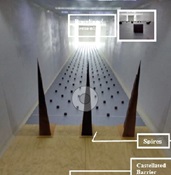Simulación de la capa límite atmosférica en el túnel de viento de la Universidad del Valle
Contenido principal del artículo
La precisa simulación del flujo de viento en la capa límite atmosférica en un túnel de viento es de suma importancia para diversas aplicaciones en ingeniería, abarcando campos como la ingeniería civil y ambiental, entre otros. En el contexto de investigar y caracterizar el comportamiento del viento en modelos a escala reducida de estructuras civiles, llevamos a cabo un estudio en el Túnel de Viento de la Escuela de Ingeniería Civil de la Universidad del Valle. El objetivo principal consistió en determinar la distribución adecuada de dispositivos generadores de turbulencia para replicar perfiles de velocidad específicos requeridos para exposiciones de tipo rural, suburbana y urbana. Este estudio se basó en la reproducción de tres perfiles de velocidad, representativos de exposiciones urbanas, suburbanas y rurales, a una escala de 1:200. Para lograr esto, implementamos generadores de vórtices de Irwin a tamaño completo, una barrera almenada y elementos de rugosidad de Counihan y Gartshore. La medición de la velocidad media en la sección de ensayos del túnel de viento se llevó a cabo utilizando sistemas de anemometría de hilo caliente y tubos de Pitot. Los resultados experimentales obtenidos al simular los perfiles de velocidad demostraron una correspondencia aceptable con los perfiles teóricos establecidos en el código de diseño NSR-10. Este estudio contribuye al avance en la comprensión y reproducción de perfiles de velocidad en el contexto de simulación de la capa límite atmosférica en túneles de viento, respaldando aplicaciones clave en el campo de la ingeniería.
- Túnel de Viento
- dispositivos pasivos
- perfil de viento
- capa límite atmosférica
- tipos de rugosidad
Hancock PE, Hayden P. Wind-Tunnel Simulation of Weakly and Moderately Stable Atmospheric Boundary Layers. Boundary-Layer Meteorol. 2018;168:29–57. DOI: https://doi.org/10.1007/s10546-018-0337-7
Barlow JB, Rae WHJ, Pope A. Low Speed Wind Tunnel Testing. Third. John Wiley & Sons, Ltd; 1999. 724 p.
Shojaee SMN, Uzol O, Kurç Ö. Atmospheric boundary layer simulation in a short wind tunnel. Int J Environ Sci Technol. 2014;11(1):59–68. DOI: https://doi.org/10.1007/s13762-013-0371-4
Kozmar H. Truncated vortex generators for part-depth wind-tunnel simulations of the atmospheric boundary layer flow. J Wind Eng Ind Aerodyn. 2011;99(2–3):130–6. DOI: https://doi.org/10.1016/j.jweia.2010.11.001
Richards PJ, Norris SE. Appropriate boundary conditions for a pressure driven boundary layer. J Wind Eng Ind Aerodyn. 2015;142:43–52. DOI: https://doi.org/10.1016/j.jweia.2015.03.003
Avelar AC, Brasileiro FLC, Marto AG, Marciotto ER, Fisch G, Faria AF. Wind tunnel simulation of the atmospheric boundary layer for studying the wind pattern at centro de lançamento de alcântara. J Aerosp Technol Manag. 2012;4(4):463–73. DOI: https://doi.org/10.5028/jatm.2012.04044912
Pires LBM, Roballo ST, Fisch G, Avelar AC, da Mota Girardi R, Gielow R. Atmospheric flow measurements using the PIV and HWA techniques. J Aerosp Technol Manag. 2010;2(2):127–36. DOI: https://doi.org/10.5028/jatm.2010.02027410
Asociación Colombiana de Ingeniería Sísmica. Reglamento Colombiano de Construcción Sismo Resistente NSR-10. Comisión Asesora Permanente para el régimen de Construcciones Sismo Resistentes (Ley 400 de 1997), editor. Bogotá; 2010.
Kuznetsov S, Ribičić M, Pospíšil S, Plut M, Trush A, Kozmar H. Flow and turbulence control in a boundary layer wind tunnel using passive hardware devices. Exp Tech. 2017;41:643–61. DOI: https://doi.org/10.1007/s40799-017-0196-z
Xie D, Xiao P, Cai N, Sang L, Dou X, Wang H. Field and Wind Tunnel Experiments of Wind Field Simulation in the Neutral Atmospheric Boundary Layer. Atmosphere (Basel). 2022;13(12):1–14. DOI: https://doi.org/10.3390/atmos13122065
Hlevca D, Degeratu M. Atmospheric boundary layer modeling in a short wind tunnel. Eur J Mech B/Fluids. 2020;79:367–75. DOI: https://doi.org/10.1016/j.euromechflu.2019.10.003
Hancock PE, Hayden P. Wind-Tunnel Simulation of Approximately Horizontally Homogeneous Stable Atmospheric Boundary Layers. Boundary-Layer Meteorol. 2021;180(1):5–26. DOI: https://doi.org/10.1007/s10546-021-00611-7
Counihan J. An improved method of simulating an atmospheric boundary layer in a wind tunnel. Atmos Environ Pergamon Press. 1969;3:197–214. DOI: https://doi.org/10.1016/0004-6981(69)90008-0
Irwin H. The Design of Spires for Wind Simulation. J Wind Eng Ind Aerodyn. 1981;7:361–6. DOI: https://doi.org/10.1016/0167-6105(81)90058-1
Gartshore IS, De Croos KA. Roughness Element Geometry Required for Wind Tunnel Simulations of the Atmospheric Wind. Am Soc Mech Eng. 1976;(76-WA/FE-18):480–5. DOI: https://doi.org/10.1115/1.3448821
Kozmar H. Characteristics of natural wind simulations in the TUM boundary layer wind tunnel. Theor Appl Climatol. 2011;106(1–2):95–104. DOI: https://doi.org/10.1007/s00704-011-0417-9
Hongtao XU, Mingshui LI, Haili LIAO YH. Simulation of Atmosphere Boundary Layer by Using Wedges and Rough Elements Technique. J Highw Transp Res Dev. 2011;5(1):41–4. DOI: https://doi.org/10.1061/JHTRCQ.0000040
Chen Z, Wei C, Chen Z, Wang S, Tang L. Numerical Simulation of Atmospheric Boundary Layer Turbulence in a Wind Tunnel Based on a Hybrid Method. Atmosphere (Basel). 2022;13. DOI: https://doi.org/10.3390/atmos13122044
Descargas

Esta obra está bajo una licencia internacional Creative Commons Atribución-NoComercial-CompartirIgual 4.0.
Los autores que publican en esta revista están de acuerdo con los siguientes términos:
Los autores ceden los derechos patrimoniales a la revista y a la Universidad del Valle sobre los manuscritos aceptados, pero podrán hacer los reusos que consideren pertinentes por motivos profesionales, educativos, académicos o científicos, de acuerdo con los términos de la licencia que otorga la revista a todos sus artículos.
Los artículos serán publicados bajo la licencia Creative Commons 4.0 BY-NC-SA (de atribución, no comercial, sin obras derivadas).





